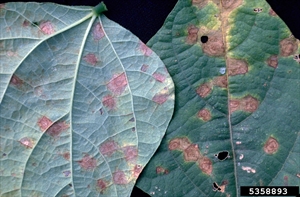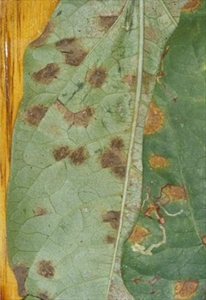Cowpea Cercospora leaf spot
Pacific Pests, Pathogens, Weeds & Pesticides - Online edition
Pacific Pests, Pathogens, Weeds & Pesticides
Cowpea Cercospora leaf spot (303)
Pseudocercospora cruenta. Previous names are Cercospora cruenta and Mycosphaerella cruenta (the sexual state). Note that some taxonomists consider that this fungus is the same as Cercospora canescens (see Fact sheet no. 301).
Asia, Africa, North, South and Central America, the Caribbean, Oceania. It is recorded from Australia, American Samoa, Fiji, Nauru, New Caledonia, Niue, Papua New Guinea, Samoa, Solomon Islands, and Tonga.
Many legumes, e.g., Canavalia galeata (sword bean), Lablab purpureus (hyacinth bean), Mucuna aterrima (Mauritius bean), Mucuna puriens (velvet bean), Phaseous lunatus (lima bean). Phaseoulus vulgaris (French bean), Vigna marina (sea bean), Vigna radiata (mung bean), Vigna unguiculata ssp. sesquipedalis (long bean), Vigna unguiculata ssp. unguiculata (cowpea). In Africa, bambara groundnut (Vigna subterranea) is also a host.
A serious leaf disease of cowpea, but also a problem on bambara groundnut (West Africa), mung and French (or common) beans. Reddish-brown fungal spots occur, up to 15 mm diameter, circular to angular, merging, often with a yellow halo (Photo 1). Sometimes the spots are limited by the veins. Infected leaves yellow and fall prematurely (Photo 2).
On mung bean, the centres of the spots become grey or white.
Spread is by spores blown in the wind, and splashed in rain. Survival is in debris left after harvest, and on alternative hosts. In Fiji, the disease is worse during cool times with temperatures of 20-25°C.
The disease is important in West Africa. Pod yields (numbers of pods and number of seeds per pod) are reduced by the leaf infections, and lower yields up to 40% are likely on susceptible varieties. Similar findings have been reported from the USA, where numbers of pods per plant are likely to be 25% lower on susceptible varieties. The impact of the disease has been reduced in the last 15-20 years because of the use of resistant varieties. However, new fungal strains are present, and there is always the potential for severe outbreaks of the disease.
Look for large reddish-brown spots (up to 15 mm), merging and causing leaves to yellow and fall. Look for the dark powdery spore masses on the spots on the lower leaf surfaces (Photo 3). When held to the light the older spots show a distinct ring around them. Dead areas fall out giving a shot-hole appearance.
CULTURAL CONTROL
Before planting:
- Use clean seed; either obtain the seed from a reliable seed supplier or clean the seed of plant debris.
- Remove volunteer plants of cowpea and other legumes before field planting.
- Reduce spread of the disease by alternating rows of cowpea (or other legumes) with maize or sorghum.
- Plant new crops from older ones with disease.
After harvest:
- Collect and burn or bury the trash after harvest.
RESISTANT VARIETIES
There are resistant cowpea varieties. Screening for resistance to Pseudocercospera cruenta has also involved evaluation for resistance to Cercospora canescens. Resistance has also been found in mung bean varieties.
CHEMICAL CONTROL
If susceptible varieties are grown, and weather conditions occur that experience suggests will result in disease outbreaks, spray with mancozeb. Begin after the crop has flowered and pods have started to develop. The number of sprays should be limited to 2-3 per crop.
____________________
When using a pesticide, always wear protective clothing and follow the instructions on the product label, such as dosage, timing of application, and pre-harvest interval. Recommendations will vary with the crop and system of cultivation. Expert advice on the most appropriate pesticides to use should always be sought from local agricultural authorities.
AUTHORS Grahame Jackson & Eric McKenzie
Information from Cercospora leaf spot of cowpea Mycosphaerella cruenta. Africa Soil Health Consortium. Plantwise. (http://africasoilhealth.cabi.org/wpcms/wp-content/uploads/2015/02/38-legumes-cercospora-leaf-spot.pdf); and from (including Photo 2) McKenzie E (2013) Pseudocercospora cruenta: PaDIL - (http://www.padil.gov.au). Photos 1&2 Howard F. Schwartz, Colorado State University, Bugwood.org.
Produced with support from the Australian Centre for International Agricultural Research under project PC/2010/090: Strengthening integrated crop management research in the Pacific Islands in support of sustainable intensification of high-value crop production, implemented by the University of Queensland and the Secretariat of the Pacific Community.






